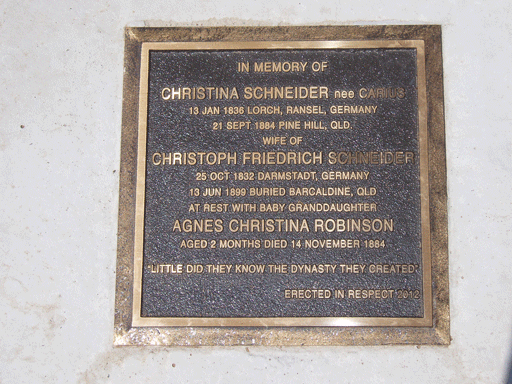The burials, in 1884, of Christina Schneider at 48 years old and her granddaughter, Agnes Christina Robinson at 2 months typify the story of the Pine Hill Cemetery during its time as a terminus for the central western railway line.
Having already been determined by surveyors as the next terminus of the railway line as it was constructed westwards; Pine Hill was described as low and flat with miserable stunted trees and water resembling pea soup.[1] Some men refused to take their wives and families there from Bogantungan, the previous terminus and considered a much healthier town.
In November 1883, the Pine Hill Progress Association sought expenditure from the Belyando Divisional Board (the local government authority responsible for the Pine Hill district) to fence the water supply with a pig-proof fence, to erect a stage from which to collect water. It also wanted the health by-laws enforced and the adoption of an earth closet system. Few improvements resulted.
Violence and depravity among some of the town’s inhabitants were also highlighted in descriptions of town life. Of the 30 businesses, 20 were grog shops.[2] There was no medical person or temporary hospital. During 1883, deaths occurred, on average, every 12 days and did not discriminate on the basis of age. Fires in business and homes in June and October did not claim any lives. Instead it appears that the environment and social factors were most significant in the loss of life.
There was a good deal of sickness at the end of 1884, fever accounting for deaths among adults and children. By this time the railway construction camps had moved further west, so the carriers were the mainstay of the town remaining there to transport goods to pastoral stations and towns north and south of the railway line. In November 1884, the Pine Hill and Alpha districts were very dry. Carriers using bullock teams were unable to operate and the faster horse teams had to carry their own feed. At Pine Hill the water hole was almost dry; water (very thick) cost 3/- a cask.[3]
Although there was enough rain in February 1885 to flood the nearby Belyando River, thus relieving the drought; sickness worsened among the children. In February and March, twelve children were buried in the Pine Hill Cemetery, most of them under one year old. The major cause of death was dysentery with intermittent fever continuing to take its toll.
With the memorial plaque in the Pine Hill Cemetery, the descendants of the Schneider family have honoured those members who laboured and died in the construction of a vital transport link, the central Queensland railway line.
[1] Peak Downs Telegram, 7 December 1883.
[2] Peak Downs Telegram, 21 December 1883.
[3] The Capricornian, 1 November 1884.
Janice Cooper
< Go Back
